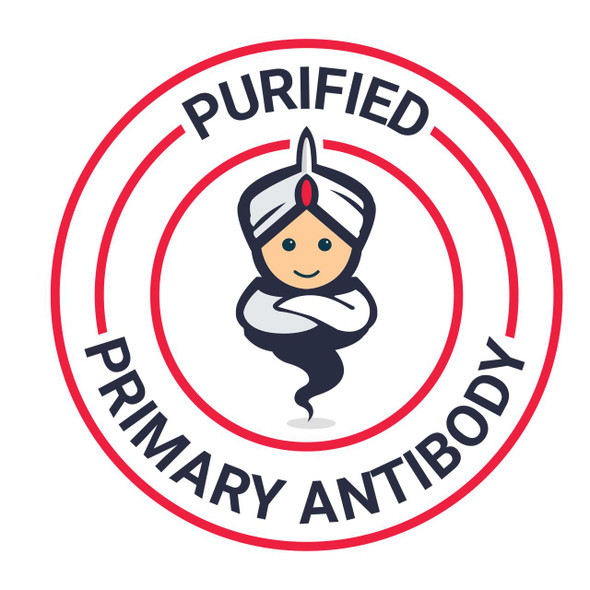CD5 monoclonal antibody (APC) (AGIM0455)
- SKU:
- AGIM0455
- Product Type:
- Antibody
- Antibody Type:
- Monoclonal Antibody
- Reactivity:
- Human
- Host Species:
- Mouse
- Isotype:
- IgG1
- Clone:
- HISM2
- Conjugation:
- APC
- Applications:
- FC
Frequently bought together:
Description
system_update_altDatasheet
| Product Name: | CD5 monoclonal antibody (APC) |
| Product Code: | AGIM0455 |
| Size: | 100 µL |
| Reactivity: | Human |
| Clone: | HISM2 |
| Applications: | Flow Cytometry |
| Conjugate: | APC |
| Isotype: | IgG1 |
| Host Species: | Mouse |
| Storage: | Store at 4°C. Avoid prolonged exposure to light. |
| Uniprot: | P06127 |
| Background: | CD5 antigen is a human cell surface T-lymphocyte single-chain transmembrane glycoprotein. CD5 is expressed on all mature T-lymphocytes, most of thymocytes, subset of B-lymphocytes and on many Tcell leukemias and lymphomas. It is a type I membrane glycoprotein whose extracellular region contains three scavenger receptor cysteine-rich (SRCR) domains. The CD5 is a signal transducing molecule whose cytoplasmic tail is devoid of any intrinsic catalytic activity. CD5 modulates signaling through the antigen-specific receptor complex (TCR and BCR). CD5 crosslinking induces extracellular Ca++ mobilization, tyrosine phosphorylation of intracellular proteins and DAG production. Preliminary evidence shows protein associations with ZAP-70, p56lck, p59fyn, PC-PLC, etc. CD5 may serve as a dual receptor, giving either stimulatory or inhibitory signals depending both on the cell type and development stage. In thymocytes and B1a cells seems to provide inhibitory signals, in peripheral mature T lymhocytes it acts as a costimulatory signal receptor. CD5 is the phenotypic marker of a B cell subpopulation involved in the production of autoreactive antibodies. |
| UniProt Protein Function: | CD5: a surface glycoprotein expressed on T cells and B-1 B cells. Rapidly recruited to the immunological synapse, lowering the response of the T cell antigen receptor. CD5 interacts with CD72/LYB-2. Promotes B-cell survival through stimulation of autocrine IL-10 production. Contains 3 SRCR domains. |
| UniProt Protein Details: | Protein type:Cell surface; Membrane protein, integral Chromosomal Location of Human Ortholog: 11q13 Cellular Component: integral to plasma membrane; plasma membrane; external side of plasma membrane Molecular Function:protein binding; transmembrane receptor activity; receptor activity; scavenger receptor activity Biological Process: cell proliferation; receptor-mediated endocytosis; T cell costimulation; cell recognition |
| UniProt Code: | P06127 |
| NCBI GenInfo Identifier: | 313104090 |
| NCBI Gene ID: | 921 |
| NCBI Accession: | P06127.2 |
| UniProt Secondary Accession: | P06127,A0N0P4, A8K9I3, |
| UniProt Related Accession: | P06127 |
| Molecular Weight: | 459 |
| NCBI Full Name: | T-cell surface glycoprotein CD5 |
| NCBI Synonym Full Names: | CD5 molecule |
| NCBI Official Symbol: | CD5 |
| NCBI Official Synonym Symbols: | T1; LEU1 |
| NCBI Protein Information: | T-cell surface glycoprotein CD5; CD5 antigen (p56-62); lymphocyte antigen T1/Leu-1 |
| UniProt Protein Name: | T-cell surface glycoprotein CD5 |
| UniProt Synonym Protein Names: | Lymphocyte antigen T1/Leu-1; CD_antigen: CD5 |
| Protein Family: | CD5 antigen |
| UniProt Gene Name: | CD5 |
| UniProt Entry Name: | CD5_HUMAN |



![APC Anti-Human CD5 Antibody [UCHT2] (AGEL0190) APC Anti-Human CD5 Antibody [UCHT2] (AGEL0190)](https://cdn11.bigcommerce.com/s-h68l9z2lnx/images/stencil/590x590/products/20114/605420/apc-anti-human-cd5-antibody-ucht2-agel0190__96570.1707494821.jpg?c=2)


